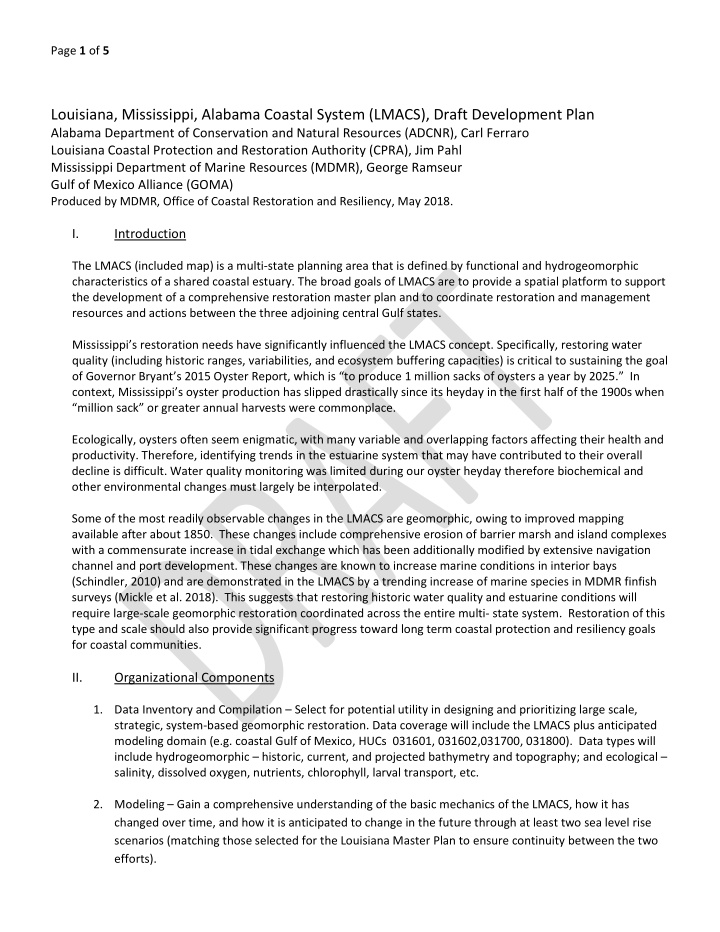



Page 1 of 5 Louisiana, Mississippi, Alabama Coastal System (LMACS), Draft Development Plan Alabama Department of Conservation and Natural Resources (ADCNR), Carl Ferraro Louisiana Coastal Protection and Restoration Authority (CPRA), Jim Pahl Mississippi Department of Marine Resources (MDMR), George Ramseur Gulf of Mexico Alliance (GOMA) Produced by MDMR, Office of Coastal Restoration and Resiliency, May 2018. I. Introduction The LMACS (included map) is a multi-state planning area that is defined by functional and hydrogeomorphic characteristics of a shared coastal estuary. The broad goals of LMACS are to provide a spatial platform to support the development of a comprehensive restoration master plan and to coordinate restoration and management resources and actions between the three adjoining central Gulf states. Mississippi’s restoration needs have significantly influenced the LMACS concept. Specifically, restoring water quality (including historic ranges, variabilities, and ecosystem buffering capacities) is critical to sustaining the goal of Governor Bryant’s 2015 Oyster Report, which is “to produce 1 million sacks of oysters a year by 2025.” In context, Mississippi’s oyster production has slipped drastically since its heyday in the first half of the 1900s when “million sack” or greater annual harvests were commonplace. Ecologically, oysters often seem enigmatic, with many variable and overlapping factors affecting their health and productivity. Therefore, identifying trends in the estuarine system that may have contributed to their overall decline is difficult. Water quality monitoring was limited during our oyster heyday therefore biochemical and other environmental changes must largely be interpolated. Some of the most readily observable changes in the LMACS are geomorphic, owing to improved mapping available after about 1850. These changes include comprehensive erosion of barrier marsh and island complexes with a commensurate increase in tidal exchange which has been additionally modified by extensive navigation channel and port development. These changes are known to increase marine conditions in interior bays (Schindler, 2010) and are demonstrated in the LMACS by a trending increase of marine species in MDMR finfish surveys (Mickle et al. 2018). This suggests that restoring historic water quality and estuarine conditions will require large-scale geomorphic restoration coordinated across the entire multi- state system. Restoration of this type and scale should also provide significant progress toward long term coastal protection and resiliency goals for coastal communities. II. Organizational Components 1. Data Inventory and Compilation – Select for potential utility in designing and prioritizing large scale, strategic, system-based geomorphic restoration. Data coverage will include the LMACS plus anticipated modeling domain (e.g. coastal Gulf of Mexico, HUCs 031601, 031602,031700, 031800). Data types will include hydrogeomorphic – historic, current, and projected bathymetry and topography; and ecological – salinity, dissolved oxygen, nutrients, chlorophyll, larval transport, etc. 2. Modeling – Gain a comprehensive understanding of the basic mechanics of the LMACS, how it has changed over time, and how it is anticipated to change in the future through at least two sea level rise scenarios (matching those selected for the Louisiana Master Plan to ensure continuity between the two efforts).
Page 2 of 5 3. Planning – Undertaken as the long-term dynamics and potential future trajectories are better defined by the data and modeling process. Economics will be modeled to inform ecosystem services and resiliency / physical protection for coastal communities. III. Hydrodynamic Modeling Scenarios Hydrodynamic modeling will be needed to fully assess the impact of these changes. The model(s) selected should be effective across the entire LMACS planning area and should be capable of interfacing with existing models to achieve adequate, system wide coverage in the most efficient manner possible. The model(s) should couple hydrodynamic and ecological factors and should support the development of at least four simulations to include historic, current and two future sea level rise scenarios. 1. Historic - Simulation timeframe will be selected based upon data quality and abundance to include: a. bathymetry / charts; b. water quality for watershed, estuarine basin and coastal ocean; c. meteorology; and d. fisheries production and biology e. aquatic community dynamics f. shell mass, diversity/structure and distribution 2. Current - Simulations will include the most recent, sufficiently detailed geomorphic data and other data needed to illustrate the evolution of the system throughout the period of the historic simulation. Some information, such as the apparent regional distribution of hypoxia east of the Mississippi River, has developed recently and may be difficult to hindcast. 3,4. Future - Simulations will match Louisiana Master Plan sea level rise scenarios IV. Informing Model inputs or Relying on Model Outputs The overarching goal of this hydrodynamic modeling effort is to understand the “mechanics of the system”. This means quantifying the effects of natural and human-induced geomorphic changes in the system as they pertain to circulation, mixing and energy dynamics, and ecological processes. Some potential initial objectives: - Assess the historic scenario (1) and identified historic trends to improve selection of desired future conditions, particularly for oyster production. In other words, let the highly productive conditions of the past inform the selection of desired future conditions and the restoration or management actions to achieve them. - Quantify circulation throughout the water column, particularly flow behavior through the ocean/ estuarine barrier tidal inlets along with major navigation channels and port/ infrastructure modifications to the system (i.e. Port of Pascagoula v Pascagoula River). - Assess ecosystem buffering capacity of current and future scenarios to natural (direct meteorological i.e. winds, storms, precipitation) and human induced (indirect meteorological, i.e. Bonnet Carré spillway openings). - Determine the economic or other viability of strategic geomorphic scale creation (manipulation using constructed habitats, landforms, etc. that are sited without direct historical reference). This could involve the creation of islands or shoals to achieve hydrodynamic objectives, storm protection / resiliency benefits, etc.
Recommend
More recommend